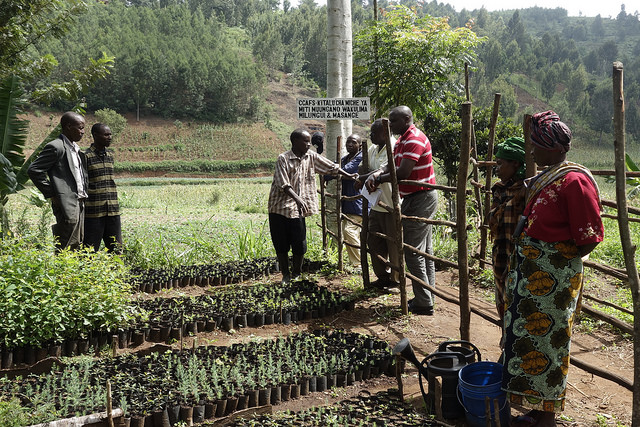Based on the article The Role of Trees in Agroecology and Sustainable Agriculture in the Tropics published in the Annual Review of Phytopathology, vol.52, by SIANI Member Roger Leakey.
What will the future of agriculture look like? The question is part of an international debate on how the world’s farmers could and should act to avoid future food crises as the world population is growing and land degradation is spreading. Current estimates are that land degradation affects 38% of the world’s total agricultural land, and 88% of this land is affected by soil erosion.
In a world where we see an increased demand of land, food-land degradation is an illustration of a downward spiral. A strive for security and wealth results in a misuse of land in the form of overgrazing, deforestation and unsustainable use of natural resources like soil and water. This behavior give quick kick-backs but will in the long run result in a breakdown of ecosystem services in the form of loss of biodiversity, nutrient cycles and an increased risk of re-occurring pests, diseases and weeds. This has paradoxically turned into a situation where the lands produce lower crop yields, which leads to lower income, increased hunger, malnutrition and insecure livelihoods.
The debate on how to avoid future food crises because of low yields has mostly tended to circle around arguments on either improved productivity through biotechnology and genetic modification, or through organic farming practices. However a third option advocating paying more attention to agroecology (an ecological approach viewing agriculture as an ecosystem in itself) has started to gain more and more attention. However, paying attention to agroecology alone will not solve the problem but is a first step toward a more sustainable future.
Direct and indirect benefits of trees
Many understand the direct benefits of trees for food security in terms of being a source of fruits, berries and nuts. What is less known are the trees’ indirect benefits on improving agroecological functions. Trees improve soil fertility by increasing biological nitrogen fixation in the earth, boost agroecosystem functions by promoting greater water infiltration, and increase biodiversity by providing shade and attracting forest-dependent species and organisms both above and below the ground. Improved biodiversity which supports natural predators naturally reduce the numbers plant-eating animals and pathogens like harmful pests, fungis and other microorganisms. This creates yields more resilient to pests and other pathogens, which are a large threat in monoculture farming.
A three-step strategy
Growing trees in farmland also called agroforestry, is a strategy with proven effectiveness to improve soil and water conditions, and increased resilience to droughts and floods. A three step strategy to resolve the issue of degrading land and the consequences it has; poverty, food and nutritional insecurity, and environmental degradation, is proposed based on the review of relevant research.
- Ecological restoration – Plantation of leguminous nitrogen-fixing trees and shrubs has a proven positive effect on soil fertility. Studies have shown a two- to threefold increase in crop yield after two years of nitrogen-fixing fallows.
- Tree domestication – Select and domesticate “elite trees” for planting to produce culturally and traditionally important and nutritious foods. The upside of biodiversity aside promoting plantation of culturally important trees has economic as well as social benefits, which is a goal in itself when creating multifunctional landscapes.
- Product commercialization – Create business and employment opportunities from the products of these agroforestry trees. To produce an income generating product/s should be seen as an incentive for farmers to diversify their land. This third step is crucial, since “the farmer is much more interested in the livelihood benefits from agroforestry systems than in the wildlife per se”.
The challenge
The effectiveness of ecological processes for creating sustainable agriculture is well-researched and a much used practice. Creating multifunctional farmlands by mixing crops with trees and shrubs not only has the potential of improving the livelihoods of farmers by providing nutritious fruits, berries and nuts but is also a successful strategy of improving the soil and land. The practice is far from unknown but is usually implemented in small-scale farming. The practice of agroforestry has not been large-scale enough to impact of land degradation on a global scale. The future challenge “is to demonstrate conclusively and to the satisfaction of policy makers, agribusiness, and academics that diverse mixed cropping systems can be productive while using natural resources sustainably.”
Prof. Roger Leakey was a former Director of Research at the International Centre for Research in Agroforestry (ICRAF 1993-1997) and Professor of Agroecology and Sustainable Development of James Cook University, in Cairns, Australia (2001-2006). He has been Vice President of the International Society of Tropical Foresters and is Vice Chairman of the International Tree Foundation. Leakey was a Coordinating Lead Author in the International Assessment of Agricultural Science and Technology for Development (IAASTD), which was approved by 58 governments in an Intergovernmental Plenary meeting in Johannesburg, South Africa in April 2008. This Assessment examined the impact of agricultural knowledge, science and technology on environmentally, socially and economically sustainable development worldwide over the last 50 years and suggested that to meet these challenges agriculture has to advance from a unifunctional focus on food production and to additionally embrace more environmental, social and economic goals – i.e. to become multifunctional.
You can find more information about Roger Leakey on his member profile here…
